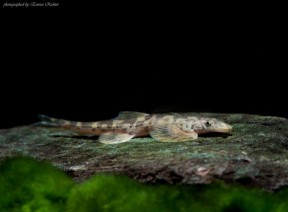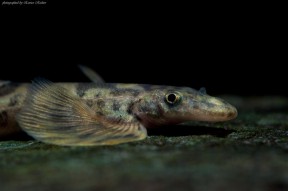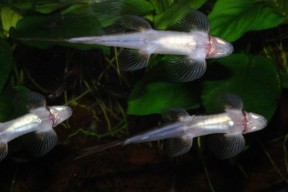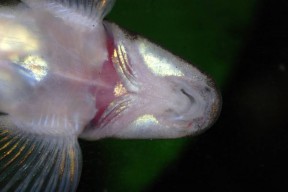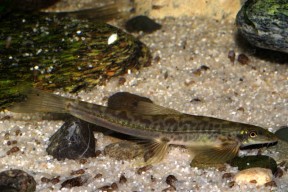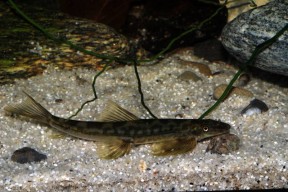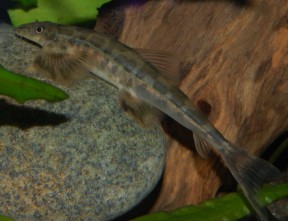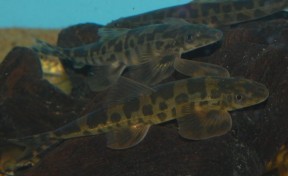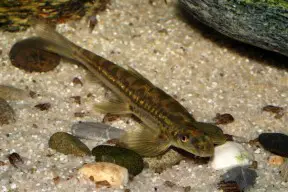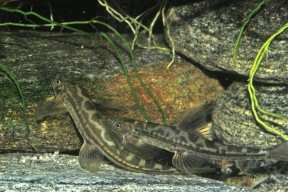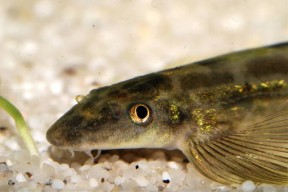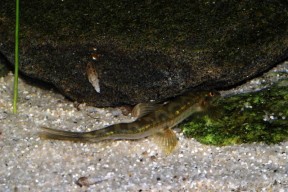Annamia normani
Vietnamese Giraffe Loach
SynonymsTop ↑
Parhomaloptera normani Hora, 1931
Etymology
Annamia: named for Annam, a former French protectorate which today comprises the central region of Vietnam.
normani: named in honour of British ichthyologist John Roxborough Norman (1898-1944), who loaned the holotype to Hora.
Classification
Order: Cypriniformes Family: Gastromyzontidae
Distribution
Recorded from numerous tributary drainages of the Mekong River in Vietnam, Laos and Cambodia, including the Khone Falls area. In Vietnam it is also known from coastal rivers draining the eastern Annamite Mountains, which are not connected to the Mekong.
Type locality is ‘Kontum, Annam, Vietnam’.
Habitat
Inhabits shallow, swiftly-flowing stretches of streams and minor rivers, most often having a noticeable gradient with substrates of rocks and cobbles. Many of its known habitats are threatened by planned hydroelectric power projects.
A typical habitat is the Duc My River in central Vietnam, where the fish were studied in a gently sloping section around 25 m wide characterised by a series of rocky riffles, rapids and deeper pools with a mixed sand and gravel substrate.
Aquatic vegetation was almost non-existent although submerged parts of terrestrial plants were common. The water was crystal clear, around 1 m deep on average, with a temperature of 86°F/30°C and pH 7.4.
Sympatric species included Akysis clavulus, Schistura namboensis, Lepidocephalichthys hasselti, Barbodes rhombeus, Rasbora paviana, Trichopsis vittata, and Parambassis siamensis, plus unidentified members of Rhinogobius and Stiphodon.
Juveniles of A. normani and R. paviana were the most abundant species at the locality, and Annamia showed a tendency to exist in large groups.
It was observed to be strictly rheophilic along with the Schistura and Rhinogobius species, but occupied a different microhabitat as it was usually found on rocky rather than gravel substrates.
Adults inhabited rapids, feeding selectively on cyanobacteria (see ‘Diet’), whereas juveniles occupied shallower water grazing organic detritus.
In the Dong Nai River, southern Vietnam sympatric species included Garra cambodgiensis, Mystacoleucus obtusirostris, Barbodes rhombeus, Rasbora paviana, Hemimyzon papilio, Homalopteroides smithi, Misgurnus anguillicaudatus, and Glyptothorax laosensis.
Maximum Standard Length
80 – 100 mm.
Aquarium SizeTop ↑
Minimum base dimensions of 120 ∗ 30 cm or equivalent are recommended.
Maintenance
Since Annamia spp. are obligate residents of riffles and rapids in nature it is essential to maintain them in a set-up designed to resemble such a habitat.
Use a substrate of gravel, sand (or a mixture), and add a layer of variably-sized water-worn rocks and boulders plus some driftwood roots or branches if you wish. While the majority of aquatic plants will fail to thrive in such surroundings, hardy genera such as Microsorum, Bolbitis, or Anubias can usually be grown attached to the décor, while bright lighting will promote the growth of aufwuchs upon which the fish will graze.
Like many species that naturally inhabit running waters they are intolerant to the accumulation of organic waste, and requires spotless water in order to thrive. High levels of dissolved oxygen and water movement are also essential with a recommended turnover of 10-15 times per hour, meaning additional powerheads, airstones, etc., should be employed as necessary.
Since stable water conditions and the presence of biofilm are obligatory for their well-being these fish should never be added to biologically-immature aquaria, and weekly water changes of 30-50 % aquarium volume should be considered mandatory.
Water Conditions
Temperature: 16 – 22 °C
pH: 6.0 – 7.5
Hardness: 18 – 179 ppm
Diet
Traditionally considered to be a micropredator feeding on insect larvae and suchlike (Rainboth, 1996), but a study by Herder and Freyhof (2006) revealed adult A. normani inhabiting the Duc My River in central Vietnam to be specialised grazers of cyanobacteria. In rapids the latter form hard encrustations on rock surfaces from which adults are able to bite chunks.
Whether this behaviour is only representative of A. normani, or even restricted to particular populations, is unclear but it would seem wise to offer dried foods containing Spirulina or similar alongside chironomid larvae (bloodworm), Tubifex, Artemia, etc., and ideally allow aufwuchs to grow on all surfaces in the tank except the viewing pane.
Gastromyzontids are often seen on sale in an emaciated state which can be difficult to correct. A good dealer will have done something about this, but if you decide to take a chance with specimens in which the body appears narrowed, especially between the pectoral and pelvic fins, they will need a constant supply of suitable foods and should be kept alone until strong enough to compete with other species.
Behaviour and CompatibilityTop ↑
Largely peaceful, although its environmental requirements limit the choice of suitable tankmates somewhat. Species inhabiting similar environments include Barilius, Opsarius, Discherodontus, Garra, larger Devario, some Rasbora, Rhinogobius, Sicyopterus and Stiphodon gobies, plus catfishes from genera such as Glyptothorax, Akysis, and Oreoglanis.
Many loaches from the families Nemacheilidae, Balitoridae, and Gastromyzontidae are also suitable, although squabbles may occur with the latter group in particular.
Annamia are found living in large aggregations in nature so a group of eight or more should be considered the minimum purchase. When kept singly or in smaller numbers they tend to be quite shy.
Sexual Dimorphism
Sexually mature females are usually a little larger and fuller-bodied than males.
Reproduction
Presumably a seasonal spawner in nature, but has not been bred in captivity.
NotesTop ↑
This species has been traded as ‘Vietnamese lizard loach’, ‘Vietnamese Homaloptera‘ and ‘Vietnamese giraffe loach’.
Annamia spp. may be confused with related genera such as those of the genus Balitoropsis. They can be identified by their more depressed body shape, elongate lower caudal-fin lobe, and the presence of a single unbranched ray in the pectoral and pelvic fins.
In A. normani the mouth is also very small (its width fitting 4-5 times in the head width), roughly horse-shoe-shaped, and located quite far away from the tip of the snout. It also has 10-11 branched pelvic-fin rays, a smooth lower lip, and its anus is closer to the anal-fin origin than the pelvic-fin base.
At least one undescribed member of the genus is thought to exist.
The family Gastromyzontidae is currently considered valid following Kottelat (2012).
It contains a number of genera which had formerly been included in several families and subfamilies, most recently Balitoridae, of which the most well-known in the aquarium hobby include Beaufortia, Formosania, Gastromyzon, Pseudogastromyzon, Hypergastromyzon, Liniparhomaloptera, Sewellia and Vanmanenia.
References
- Hora, S. L., 1931 - Annals and Magazine of Natural History Series 10 6(35): 582-586
On a new homalopterid fish from Annam. - Freyhof, J., D. V. Serov and T. N. Nguyen, 2000 - Bonner Zoologische Beiträge 49(1-4): 93-99
A preliminary checklist of the freshwater fishes of the River Dong Nai, South Vietnam. - Herder, F. and J. Freyhof, 2006 - Journal of Fish Biology 69(2): 571-589
Resource partitioning in a tropical stream fish assemblage. - Kottelat, M., 2001 - WHT Publications Ltd., Colombo: 1-198
Fishes of Laos. - Kottelat, M., 2012 - Raffles Bulletin of Zoology Supplement 26: 1-199
Conspectus cobitidum: an inventory of the loaches of the world (Teleostei: Cypriniformes: Cobitoidei). - Kottelat, M., 1998 - Ichthyological Exploration of Freshwaters 9(1): 1-128
Fishes of the Nam Theun and Xe Bangfai basins, Laos, with diagnoses of twenty-two new species (Teleostei: Cyprinidae, Balitoridae, Cobitidae, Coiidae and Odontobutidae). - Kottelat, M., 2013 - Raffles Bulletin of Zoology Supplement 27: 1-663
The fishes of the inland waters of southeast Asia: a catalogue and core bibiography of the fishes known to occur in freshwaters, mangroves and estuaries. - Rainboth, W. J., 1996 - FAO, Rome: 1-265
Fishes of the Cambodian Mekong. FAO Species Identification Field Guide for Fishery Purposes. - Randall, Z. S. and L. M. Page, 2012 - Zootaxa 3586: 329-346
Resurrection of the genus Homalopteroides (Teleostei: Balitoridae) with a redescription of H. modestus (Vinciguerra 1890). - Tang, Q., H. Liu, R. Mayden and B. Xiong, 2006 - Molecular Phylogenetics and Evolution 39(2): 347-357
Comparison of evolutionary rates in the mitochondrial DNA cytochrome b gene and control region and their implications for phylogeny of the Cobitoidea (Teleostei: Cypriniformes). - Šlechtová, V., J. Bohlen and H. H. Tan, 2007 - Molecular Phylogenetics and Evolution 44(3): 1358-1365
Families of Cobitoidea (Teleostei; Cypriniformes) as revealed from nuclear genetic data and the position of the mysterious genera Barbucca, Psilorhynchus, Serpenticobitis and Vaillantella.

